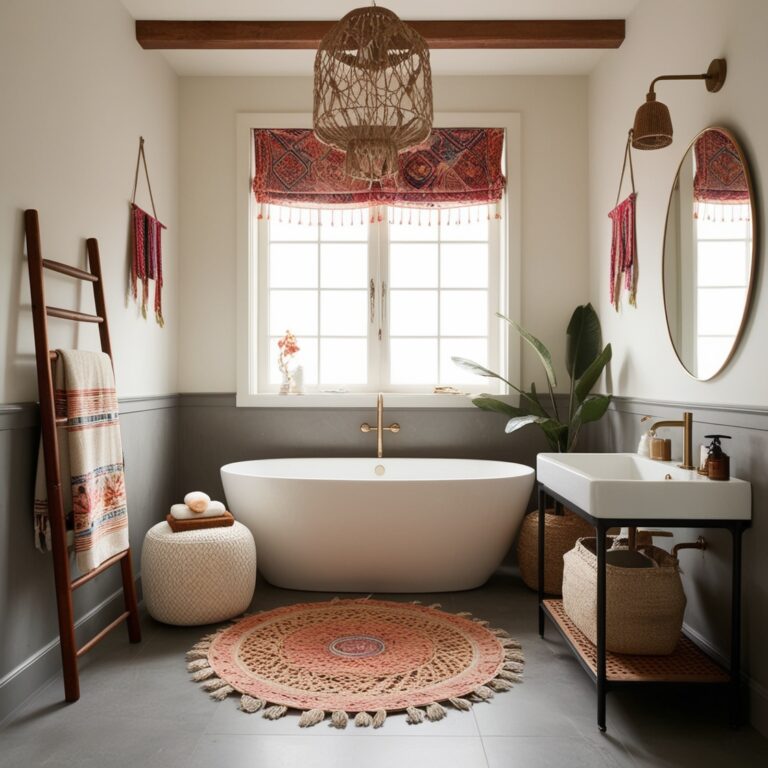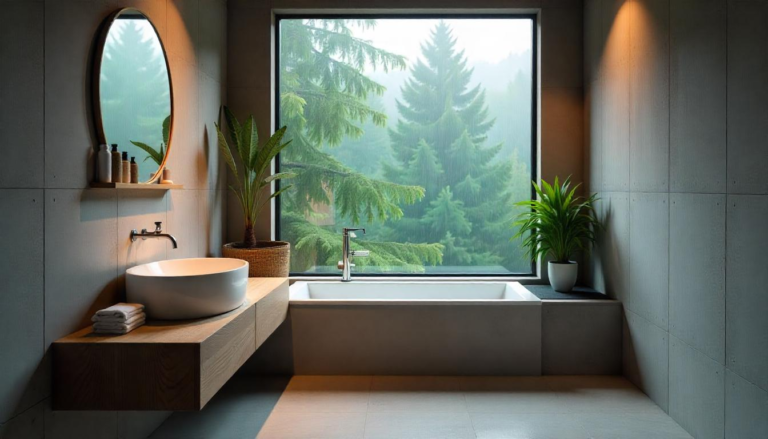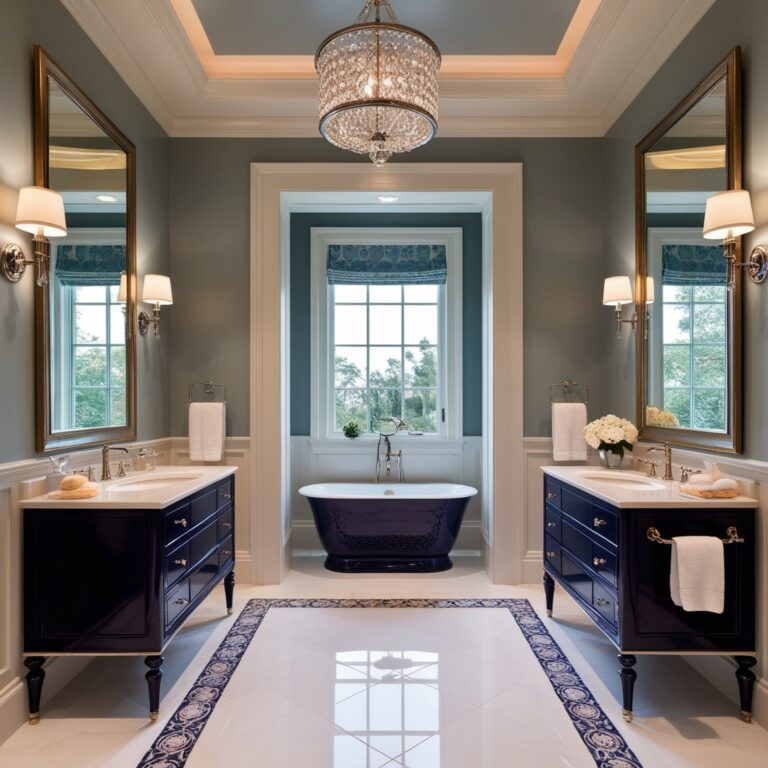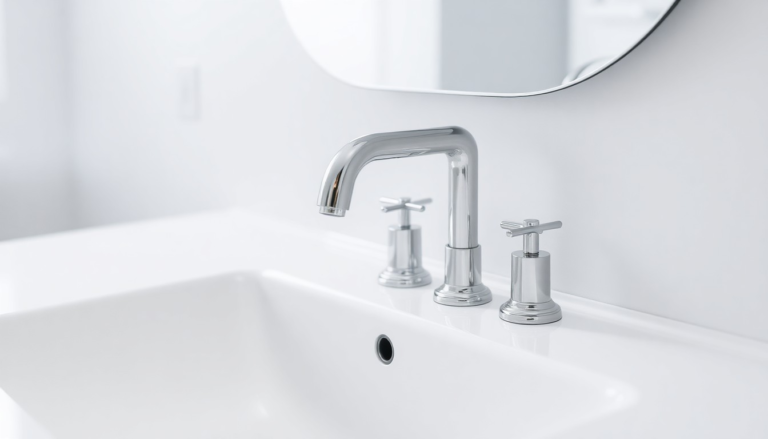22+ Japanese Style Bathroom Ideas for a Serene Space
Japanese-style bathrooms are revered for their minimalism, tranquility, and connection to nature. If you’ve ever visited Japan or experienced the calm of its bathhouses, you’ve felt the serene atmosphere that these spaces cultivate. But what exactly makes a Japanese bathroom so special? It’s more than just sleek design; it’s a lifestyle choice, a philosophy that sees the bathroom not only as a functional space but as a sanctuary.
In this article, we’ll explore over 22 Japanese-inspired bathroom ideas that will help transform your bathroom into a serene space that brings both relaxation and beauty into your everyday routine.
Embrace Minimalism
Simplicity is the cornerstone of Japanese design. When it comes to bathrooms, this means choosing clean lines, neutral colors, and uncluttered spaces. But it’s not just about the visual aspects. A minimalist Japanese bathroom is one that eliminates unnecessary items, focusing only on what’s essential.
A clutter-free bathroom is a peaceful bathroom. Consider keeping countertops free of toiletries and using hidden storage to keep your essentials out of sight. Opt for simple cabinetry with natural wood finishes or even floating vanities to add to the clean and airy look.
One of the best things about a minimalist bathroom is that it forces you to slow down. With fewer distractions, you can focus on the process of bathing as a ritual, almost like a meditative experience. This aspect of mindfulness is key in creating that serene atmosphere.
Natural Materials: Wood, Stone, and Bamboo
Nature plays a significant role in Japanese aesthetics, so it’s no surprise that natural materials are heavily incorporated in bathroom design. Wood, stone, and bamboo are some of the most popular materials, bringing the outside in and creating a spa-like atmosphere that feels grounded and organic.
Wood is used in everything from bath surrounds to sinks and flooring. For a truly authentic Japanese-style bathroom, consider using teak or cedar wood for your soaking tub or wall panels. These materials provide a warm and inviting contrast to the cool tones of stone and tile.
Bamboo is another popular material that complements Japanese bathroom decor beautifully. Bamboo has a soft yet durable quality, making it perfect for things like towel racks, bath mats, or even shower curtains. It’s sustainable, affordable, and gives a calming vibe that’s perfect for unwinding.
Stone, whether in the form of pebbled floors or a large stone basin, adds to the organic feel of your space. This rough yet calming element brings texture and balance to the clean, soft lines of wood and bamboo.
Soaking Tubs: The Heart of a Japanese Bathroom
If there’s one feature that defines a Japanese bathroom, it’s the soaking tub or ofuro. This deep, wooden tub is meant for soaking rather than scrubbing, and it’s central to the Japanese bathing ritual. Unlike the typical Western bathtub, which is often used for both washing and soaking, the Japanese ofuro is a place to relax and meditate.
To create a Japanese-inspired bathroom in your own home, consider installing a deep soaking tub. The tub can be made of various materials like wood or stone, and it’s often elevated, making it perfect for sitting and relaxing. If you’re short on space, there are smaller, more compact versions available that fit perfectly into apartment bathrooms.
The key is to create a sense of ritual. When you take a bath in a Japanese-style soaking tub, it’s not about getting clean quickly—it’s about taking your time, soaking deeply, and letting the warm water ease your tension. For an added touch, you can install a rain showerhead above the tub to mimic the calming effect of natural rainfall.
Incorporate Sliding Doors
Sliding doors are another hallmark of Japanese design, allowing spaces to flow and feel larger than they are. In the bathroom, sliding doors can be used to separate the toilet area from the bath area, keeping things organized while still maintaining an open feel. These doors also make the bathroom feel more open and airy, allowing for a seamless transition between spaces.
If you’re remodeling your bathroom, think about replacing traditional hinged doors with shoji-style sliding doors. The translucent nature of these doors adds a delicate, diffused light, which is perfect for the peaceful ambiance that defines Japanese bathrooms.
Alternatively, if you’re not ready to fully commit to sliding doors, bifold doors or barn-style doors in wood or frosted glass can still bring a Japanese-inspired vibe to the space.
Zen Garden Elements
The concept of zen gardens is all about creating a peaceful oasis using simple elements of nature. You don’t need a large outdoor space to create a zen garden—this can be achieved right inside your bathroom!
To add a touch of zen to your bathroom, consider creating a small indoor zen garden with pebbles, moss, and miniature plants. A tray filled with these elements can sit on a countertop, or you can add some stones and bamboo around the tub area.
Koi fish ponds or water features are another way to enhance the peaceful atmosphere. If space allows, you can add a waterfall feature or even a small fountain to create the calming sound of running water, which is known for its soothing properties.
Low Lighting for a Calming Atmosphere
In a Japanese bathroom, lighting is often subtle and soft, designed to enhance the tranquil ambiance rather than overwhelm the senses. Low lighting is key, with sources of light coming from wall sconces, pendant lights, or recessed lighting.
Instead of harsh overhead lights, opt for warm, dimmable LED lights to provide a relaxing glow. You can also use paper lanterns or frosted glass fixtures, which mimic the natural light in Japanese homes. The goal is to create an environment that feels peaceful and undisturbed, so avoid any overly bright or distracting lights.
Adding a touch of candlelight can also be a wonderful way to enhance the serene atmosphere, especially when paired with calming scents like lavender or eucalyptus. Just be sure to keep candles away from any flammable materials, and never leave them unattended.
Add Japanese Artwork and Calligraphy
Japanese art can be used to decorate the walls of your bathroom. Look for traditional Japanese prints, calligraphy, or even modern interpretations of Japanese motifs. Popular themes include mountains, cherry blossoms, waves, and koi fish.
The key is to choose subtle, minimalistic art that doesn’t overpower the space. A large canvas or framed piece of artwork can be hung above the tub or near the toilet for an added focal point.
Incorporating Japanese characters through calligraphy prints adds a touch of authenticity to the room. You could even write a personal mantra or meaningful phrase in Japanese to encourage relaxation and peace every time you step into the bathroom.
Aromatherapy and Essential Oils
Japanese bathrooms often incorporate aromatherapy to enhance the bathing experience. Essential oils like ylang-ylang, cherry blossom, and green tea are frequently used to create a soothing, fragrant environment.
To bring this into your own bathroom, consider using an essential oil diffuser or aromatherapy candles to fill the space with gentle scents. You can also add a few drops of your favorite essential oils to your bathwater to elevate the soaking experience.
For a truly authentic experience, consider incorporating matcha green tea into your bathing routine. Not only is matcha rich in antioxidants, but it also promotes relaxation and can leave your skin feeling rejuvenated. Matcha bath salts or matcha body scrubs are perfect additions to your Japanese-inspired bathroom.
Create a Spa-Like Experience with Bamboo Bath Accessories
To complete your Japanese bathroom, don’t forget about the little details. Bamboo accessories like towel racks, soap dishes, bath mats, and storage baskets will contribute to the overall natural, soothing vibe. Bamboo is eco-friendly, durable, and perfectly suited for a serene bath environment.
For a more luxurious experience, you can also add a bamboo bath stool. This simple yet functional piece of furniture is often found in traditional Japanese bathhouses. It allows you to sit while you shower or scrub, adding to the spa-like atmosphere of the space.
Consider a Japanese-Inspired Sink or Vanity
A Japanese-inspired sink often has clean lines and is made from stone, wood, or ceramic. Choose a low-profile basin to complement the rest of your minimalist bathroom design. Pair the sink with a floating vanity or natural wood cabinetry for a seamless, minimalist look.
Another option is a copper or brass sink, which adds an element of warmth and elegance to your Japanese bathroom. A low countertop with simple shelves below can help keep the space uncluttered and organized.
Final Thoughts
Creating a Japanese-inspired bathroom is about more than just the physical design—it’s about creating an atmosphere of serenity and mindfulness. By focusing on minimalism, natural materials, and calming rituals, you can transform your bathroom into a peaceful retreat where you can escape the hustle and bustle of daily life.
Whether you opt for an authentic ofuro soaking tub or incorporate small touches like bamboo accessories or zen garden elements, the key to achieving the serene space you crave lies in choosing simple, organic elements that make you feel grounded, peaceful, and connected to nature.
Ready to create your Japanese-style bathroom? Take inspiration from the ideas above and start making small changes that will bring your space to life!





